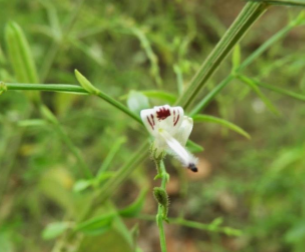Kalmegh

Synonym: Justica latebrosa Russ. ex Wall.; J. paniculata Burm. f.
Family: Acanthaceae
Ayurvedic Name: Kalmegh
Hindi Name: Kalmegh
Trade Name: Kalmegh
Habit: Creeping herb
Part Used: Whole plant
Active Ingredient: Andrograpanin, Andrographoside
Biological activity: Antipyretic, Antimalarial, abortifacient, Blood purifier, Anti-inflammatory, Antimicrobial, Analgesic, Antibiotic, Anticancer
Traditional and Therapeutic use:The plant is acrid, cooling, laxative, antipyretic, antiperiodic, anti-inflammatory, expectorant, sudorific, anthelmintic, digestive and stomachic. It is useful in burning sensation, chronic fever, malaria and intermittent fever, inflammation, cough, bronchitis, skin diseases, intestinal worm, dyspepsia, flatulence, colic, diarrhea, dysentery, hemorrhoids and vitiated condition of pitta.
Morphological and floral characteristics: Erect, annual herb, 30-90 cm tall with upper part of stem quadrangular while the lower part nearly rounded stem. Leaves are opposite sessile or subsessile, linear-lanceolate or lanceolate, 3-8 cm long, acute, glabrous or minutely puberulous beneath and base cuneate, margin slightly undulate.
Distribution: The species occurs throughout in the tropical regions of India. In Gujarat it is distributed in Bhavnagar, Ghumli.
Varieties: At present, no certified varieties are available.
Climate and Soil: The plant comes up well in tropical and subtropical regions all over India. It is a hardy species, therefore, can be grown in medium fertile sandy loam to clay-loam soils. It can withstand partial shade of trees, but cultivated in open fields.
Main field plantation
Transplanting and optimum spacing: Six weeks old seedlings are planted in field at 30 x 15 cm or 30 x 30 cm spacing, approximately, 110,000 plants are required as planting material for 1 hectare of land.
Land preparation: The land should be prepared well by repeated ploughing to make soil pulverized.
Fertilizers: For main field, FYM @ 20 t/ha is given as basal application. NPK (75:75:50 kg/ha) is given in two split doses i.e. first at planting stage and second 40 days after plantation.
Weed control: Two weeding per month is required.
Irrigation: 4-6 light irrigations are required till harvesting the crop.
Diseases and pest control: It is a hardy plant and not attacked by any pest and disease.
Crop maturity and harvesting: The crop matures after 120 days of sowing. It is harvested when most plants are in bloom. It is at this stage, the plants should be uprooted. However, a small lot of healthy plants should be left in the field for seed production. When the fruits become mature, these should be picked up and dried in the sun and seeds are collected. The seeds should be kept in open sun for complete drying.
Post-harvest management: After uprooting the plant, first it should be dried in the sun for two days and afterwards in the shade. Properly dried material should be packed in laminated gunny bags, lest it absorbs moisture. The harvested dry material should be stored in dark, airy and moisture-free places.
Yield: The total root yield per hectare is estimated to be 2.5 MT on dry weight basis.
Nursery technique
Nursery is prepared with soil, sand and organic matter in 1:1:1 ratio and sown in early September at 5 cm spacing in rows and it takes 8-10 days for germination to commence. For nursery beds, 20 kg FYM / square meter is mixed in the soil. About 650-750 gm seeds are required for raising nursery for one hectare of land. Seeds are soaked in water for 24 hours and sown in the nursery beds in early September. Light shower after sowing of seedlings in raise bed.